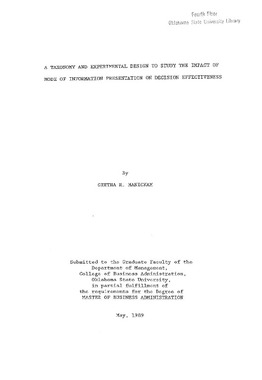| dc.contributor.advisor | Kletke, Marilyn G. | |
| dc.contributor.author | Manickam, Geetha R. | |
| dc.date.accessioned | 2015-09-14T21:07:25Z | |
| dc.date.available | 2015-09-14T21:07:25Z | |
| dc.date.issued | 1989-05 | |
| dc.identifier.uri | https://hdl.handle.net/11244/18048 | |
| dc.description.abstract | Decision effectiveness depends on the mode of information presentation that provides information to support decision making, which in turn is a function of the characteristics of the task at hand. Task characteristics depend primarily on the type of the task and the level at which the decision is being made in the organization. Thus, for studies attempting to evaluate the impact of mode of information presentation on decision effectiveness, it is important to appreciate the interdependence between the type of task (structured/semistructured/unstructured) , level of managerial activity (top/middle/lower), and the mode of information presentation (tables/graphs/tables & graphs etc.). | |
| dc.description.abstract | We propose a two-dimensional (three-by-three) taxonomy, based on Gorry and Scott Morton's [GoS71] framework, within which the existing studies have been categorized. It is evident, that most researchers have focused on structured decisions and/or decisions at the operational level. | |
| dc.description.abstract | A set of experiments are proposed to evaluate the impact of the mode of information presentation across the structured-unstructured continuum for the three levels of managerial activity. We consider only two modes of information presentation - graphs and tables. For each level of managerial activity, irrespective of the structure a specific task activity is identified. The structure is then varied by changing the number of variables to be processed. The task environment involves the evaluation of the emergency medical services provided by a hypothetical ambulance firm AMBUCARE. | |
| dc.description.abstract | The experiments will be administered to 18 groups of randomly selected subjects from a homogenous population, who will be randomly assigned to the 9 cells and the two modes of presentation. The decision effectiveness will be measured by comparing the subjects' decisions to a "near-optimal" solution obtained using analytical methods. The impact of mode of information presentation on decision effectiveness will then be analyzed using statistical methods. | |
| dc.format | application/pdf | |
| dc.language | en_US | |
| dc.rights | Copyright is held by the author who has granted the Oklahoma State University Library the non-exclusive right to share this material in its institutional repository. Contact Digital Library Services at lib-dls@okstate.edu or 405-744-9161 for the permission policy on the use, reproduction or distribution of this material. | |
| dc.title | Taxonomy and experimental design to study the impact of mode of information presentation on decision effectiveness | |
| osu.filename | Thesis-1989R-M278t.pdf | |
| osu.accesstype | Open Access | |
| dc.type.genre | Master's Report | |
| dc.type.material | Text | |
| thesis.degree.discipline | Management Information Systems | |
| thesis.degree.grantor | Oklahoma State University | |
